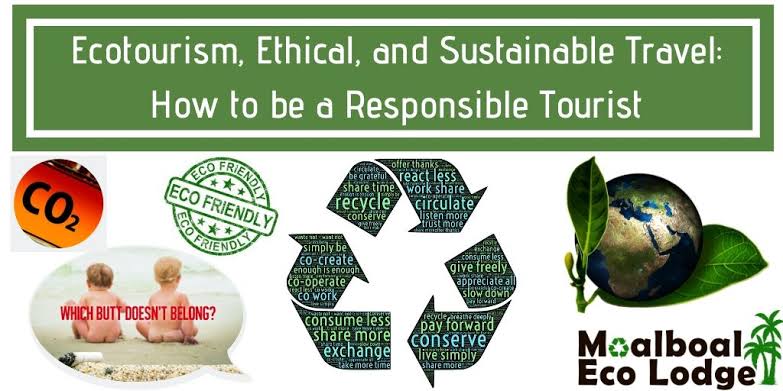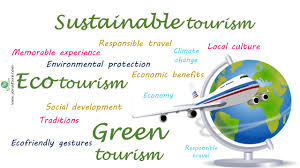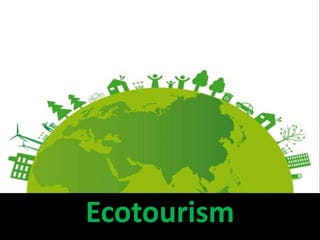Ecotourism
Role, Impact and Case Studies of Ecotourism
What is Ecotourism:
Ecotourism is a responsible and sustainable form of tourism that emphasizes the appreciation of natural environments, biodiversity, and cultural heritage. It seeks to minimize the impact on ecosystems and promote conservation while providing meaningful experiences for travelers. Key principles include environmental protection, community involvement, education, and supporting local economies. Ecotourism strives to create a positive impact by fostering a deeper understanding of the environment and encouraging practices that contribute to long-term ecological sustainability.
Role of Ecotourism:
Thus, it plays a crucial role in conservation through various mechanisms that contribute to the protection and preservation of natural environments. Here’s how ecotourism fulfills this important role:

Funding Conservation Efforts:
Mechanism: Revenues generated from it, such as entrance fees, guided tours, and accommodations, often directly fund conservation initiatives.
Impact: Financial support can be directed towards maintaining protected areas, anti-poaching efforts, habitat restoration, and wildlife conservation projects.
Raising Environmental Awareness:
Mechanism: Thus, it experiences often include educational components, fostering awareness about the importance of conservation and sustainable practices.
Impact: Informed and aware tourists are more likely to support and engage in conservation efforts, both during their travels and upon returning home.
Supporting Local Conservation Initiatives:
Mechanism: Thus, it encourages partnerships between tourism operators and local communities, leading to joint efforts in conservation.
Impact: Collaborative initiatives can address local environmental challenges, promote responsible land use, and empower communities to actively participate in conservation.
Reducing Habitat Destruction:
Mechanism: Well-managed operations prioritize minimizing the impact on natural habitats and ecosystems.
Impact: By avoiding habitat destruction and practicing sustainable tourism. Thus, it helps safeguard critical environments from degradation.
Providing Economic Incentives for Conservation:
Mechanism: The economic benefits derived from it, such as job creation and income generation, create incentives for local communities to actively engage in and support conservation efforts.
Impact: When conservation is linked to economic well-being, there is greater motivation to protect natural resources for future sustainable use.
Promoting Sustainable Wildlife Tourism:
Mechanism: Ethical wildlife tourism practices within ecotourism emphasize responsible viewing, minimizing disturbance to wildlife.
Impact: By promoting sustainable wildlife tourism. Thus, it helps protect animal habitats and reduce the negative impact of tourism on wildlife behavior.
Involving Tourists in Conservation Activities:
Mechanism: Some ecotourism programs involve tourists in hands-on conservation activities or citizen science projects.
Impact: Thus, tourist participation creates a sense of stewardship, fostering a direct connection between visitors and the conservation of the environments they explore. In essence, ecotourism integrates conservation into the tourism experience, creating a symbiotic relationship where responsible travel practices directly contribute to the protection and sustainability of natural ecosystems. Thus, this alignment of tourism and conservation goals is essential for addressing environmental challenges and ensuring the long-term health of our planet.
Impact of Ecotourism:
Therefore, the impact of ecotourism can be multifaceted, encompassing environmental, social, and economic dimensions. Here are key parts of its effect:
Environmental Impact of Ecotourism:
Conservation: Ecotourism can contribute to the conservation of natural habitats and wildlife. Revenues generated may fund protected areas, anti-poaching efforts, and habitat restoration projects.
Biodiversity: Responsible ecotourism helps in the preservation of biodiversity by promoting sustainable practices that minimize disturbance to ecosystems.
Social Impact of Ecotourism:
Community Empowerment: It often involves local communities in decision-making processes, creating economic opportunities through employment and local business development.
Cultural Preservation: By encouraging respect for local cultures and traditions, ecotourism can contribute to the preservation of indigenous knowledge and practices.
Economic Impact of Ecotourism:
Local Economy: Revenue generated from ecotourism can stimulate local economies, providing livelihoods and supporting small businesses. This can reduce dependence on unsustainable practices like logging or poaching.
Diversification: Communities that embrace ecotourism can diversify their income sources, reducing reliance on single industries that may have negative environmental impacts.
Education and Awareness:
Environmental Education: Thus, tourists engaging in ecotourism often gain a deeper understanding of environmental issues and conservation. Thus, this expanded mindfulness can prompt all the more earth cognizant way of behaving.
Challenges and Risks:
Over-Tourism: Popular ecotourism destinations may face challenges related to over-tourism, leading to increased pressure on ecosystems, infrastructure, and local communities.
Ecological Impact: If not managed properly, even well-intentioned can have unintended ecological consequences, such as habitat disruption and wildlife disturbance.

Long-Term Sustainability:
Balancing Act: Achieving a balance between economic benefits, cultural preservation, and environmental protection is crucial for the long-term sustainability of initiatives.
Policy and Regulation of Ecotourism:
Effective Governance: Thus, the impact of ecotourism is often influenced by the effectiveness of policies and regulations in place. Strong governance is essential to ensure responsible practices and mitigate negative consequences. While ecotourism has the potential to bring about positive change, careful planning, community involvement, and ongoing monitoring are necessary to maximize benefits and minimize potential drawbacks.
Benefits of Ecotourism:
Conservation of Biodiversity: Ecotourism contributes to the preservation of diverse ecosystems and wildlife habitats, fostering biodiversity conservation.
Community Empowerment: Local communities often benefit from ecotourism through employment opportunities, income generation, and community development projects, leading to improved livelihoods.
Cultural Preservation: Ecotourism encourages respect for local cultures and traditions, promoting cultural preservation and providing a platform for communities to showcase their heritage.
Educational Opportunities: Tourists engaging in ecotourism often gain insights into environmental issues, conservation efforts, and the importance of sustainable practices, fostering environmental awareness.
Economic Diversification: Ecotourism provides an alternative and sustainable source of income for communities, reducing reliance on potentially harmful industries like logging or agriculture.
Conservation Funding: Revenues generated from ecotourism activities are often directed towards conservation initiatives, supporting the maintenance of protected areas and the well-being of their ecosystems.
Low Environmental Impact: Sustainable practices inherent in ecotourism, such as eco-friendly accommodations and responsible tour operations, aim to minimize the environmental footprint of tourism activities.
Preservation of Natural Landscapes: Thus, it encourages the protection of natural landscapes and scenic beauty, preserving them for future generations to enjoy.
Promotion of Sustainable Practices: The principles of it promote responsible and sustainable travel behaviors, influencing both tourists and the tourism industry to adopt environmentally conscious practices.
Enhanced Quality of Tourism Experience: Thus, it often provides unique and authentic experiences, allowing tourists to connect more intimately with nature and local cultures, enriching their overall travel experience.
Case Studies of Ecotourism:
Costa Rica’s Ecotourism Model: Costa Rica is often cited as a leader in it. The country has focused on preserving its diverse ecosystems while promoting sustainable tourism.
Results: Protected areas cover more than 25% of the country, and it has contributed significantly to its economy. The emphasis on biodiversity, national parks, and responsible tourism practices has made it a successful destination.
Galápagos Islands, Ecuador:
Approach: The Galápagos Islands have implemented strict conservation measures to protect its unique flora and fauna. Sustainable tourism practices are enforced to minimize impact on this fragile ecosystem.
Results: With limited access and regulated tourism, the Galápagos has maintained its extraordinary biodiversity. Revenue generated from carefully managed tourism contributes to conservation efforts and local communities.
Namib Rand Nature Reserve, Namibia:
Approach: Namib Rand is a private nature reserve committed to conservation through sustainable tourism. It focuses on preserving the desert ecosystem while providing unique, low-impact experiences for visitors.
Results: The reserve has successfully combined conservation with tourism, protecting wildlife and landscapes. Income generated supports local communities, and tourists gain insights into desert ecology while contributing to its preservation.
Biosphere Reserves in Spain:
Approach: Spain has several UNESCO-designated Biosphere Reserves that integrate conservation and sustainable development. These areas balance environmental protection with the well-being of local communities.
Results: These reserves serve as living laboratories for sustainable practices, promoting eco-friendly tourism. They showcase how tourism can coexist with nature, providing economic benefits while preserving biodiversity.
Maasai Mara Conservancies, Kenya:
Approach: In the Maasai Mara, community-led conservancies have embraced to protect wildlife and traditional Maasai culture. These conservancies involve local communities in tourism management.
Results: Revenue from it benefits both conservation and local communities. It has reduced poaching, supported education and healthcare initiatives, and created a model where wildlife and people thrive together. These case studies highlight diverse approaches to it, emphasizing the importance of community involvement, conservation strategies, and sustainable practices in achieving success.
Conclusion:
In conclusion. Thus, it emerges as a beacon of sustainable travel, fostering a delicate equilibrium between exploration and environmental preservation. Its impact extends beyond leisure, making meaningful contributions to biodiversity conservation, local community empowerment, and cultural respect. Successful models demonstrate the potential for tourism to be a force for positive change when grounded in responsible practices. Yet, vigilance is required to address challenges like over-tourism and potential ecological disruptions. As a conscientious approach to travel gains momentum globally. Thus, it stands as a promising paradigm, inviting a collective commitment to the protection of our planet’s natural wonders and the well-being of its diverse inhabitants.
